
Welcome To Worldbuilding 🌍 ✨
RSS+ (Farcaster) & The Future of Social Graphs In The Creator Economy
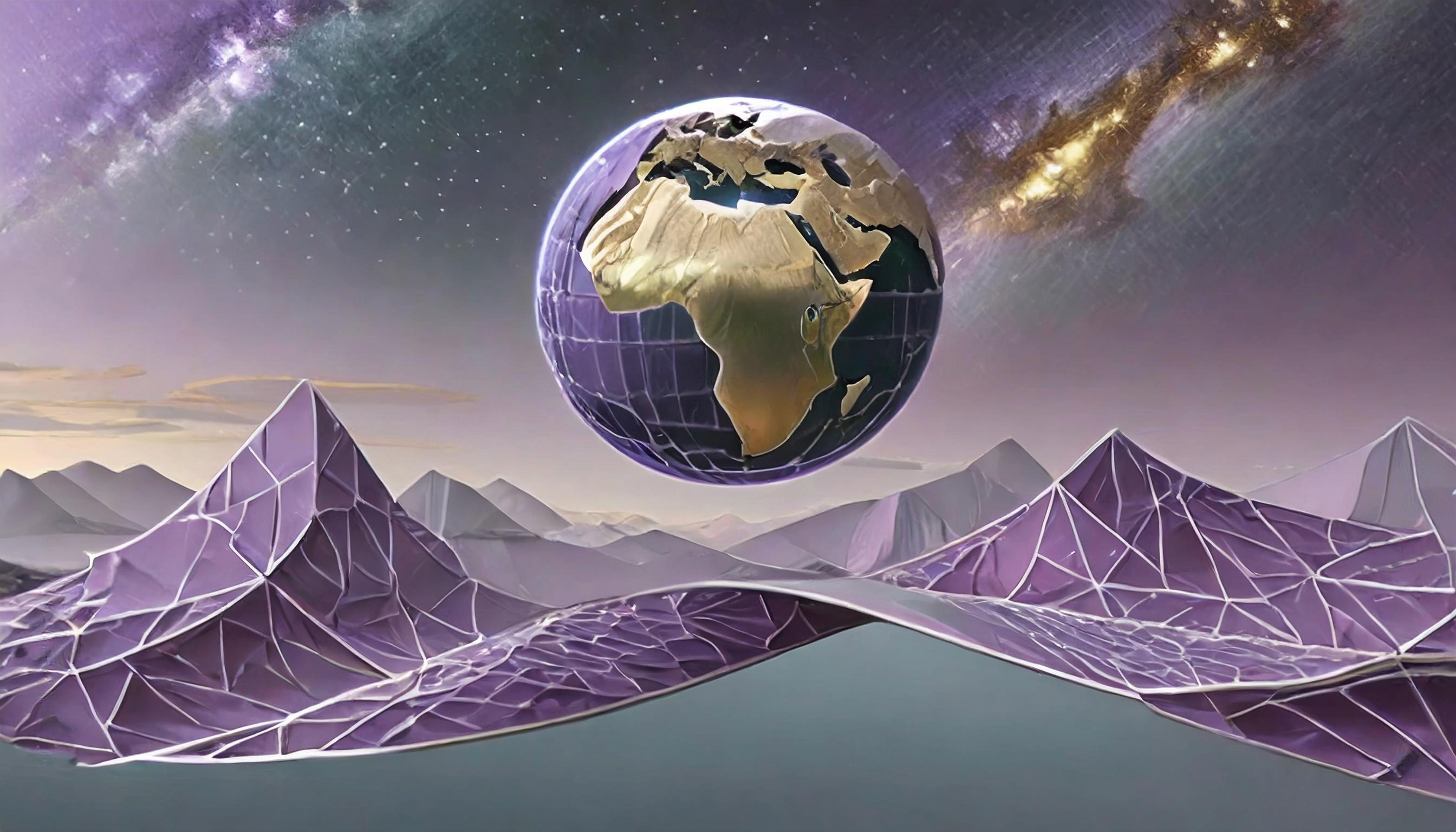
For the first time in my life, I am excited to build on social media 🌐
No more bait-and-switch social media platforms, nerfing my reach until I pay for advertising.
No more fracturing my self across 10 platforms, burning out along the way.
I feel as though I can truly build my own world, in public, so others can join me on my journey ✨
Welcome to Worldbuilding 🌍 ✨

First off, hello to the 32 subscribers who joined me since my first Recalibrating Entry 🧭 ✨ I'm blown away at this response after only one week and greatly appreciate you taking the time to read my words 🫡
For those new here, Paragraph is the medium-form extension of my long-form Recalibrating newsletter currently on Substack & my website:
🧭 Recalibrating = align the self & identify your path forward
🌎 Worldbuilding = practical Recalibrating
The goal of Worldbuilding is to help you build in your unique, calibrated style, leaving a trail for those walking the path behind you so that we can learn in public, together.
To help me build up my own world, please consider joining the /cal channel on FC & sharing this frame/entry with someone who may find it valuable. Word of mouth is the best way to build a world with people who resonate with one another 🤝 ✨

It’s incredibly satisfying to feel that what I am building here on @farcaster is perhaps the last time I will ever need to build on a social network
I realize that sounds like a bold statement, a prediction of the future. Prescience 👀
To help you understand the future as I see it, I thought it would be helpful to take a look back at where Farcaster came from and why the original name of "RSS+" provides a helpful prediction of its future in the creator economy as a whole.
An overview of today's entry:
Problems with current social media;
How Farcaster Social Graph + blockchain integration = solutions;
The context tying the problems to the solutions; and
Why you should care to build your own world rather than stay within the walled worlds of web2.
Let's dive in ✨

Cross-posting Burnout: keeping up with each platform requires a ton of work;
High Noise/Low Signal: Very few people engage meaningfully with content, if they do, it’s spread across all social platforms (no feedback = no recalibration);
Poor Payment Rails: It's difficult to directly tip/pay the creator, or very high platform fees (reduced micro-transaction ability);
Low/No Network effect: Algorithmic boosting is usually reserved for large creators (small creators can’t leverage Reed’s Law);
Creators burn themselves out trying to keep up with 10+ social media platforms, each refusing to work with the others. Sure, you can use an aggregator account that cross-posts for you, but the web2 platforms often recognize this 3rd-party posting and algorithmically nerf the posts.
Feedback is an essential part of building your world. If you do not know what your audience values, you can't recalibrate your publishing system to augment the value you are sharing.
Additionally, this feedback is spread across 10+ platforms, making it difficult to keep track. There's no linked social graph. Even if there is feedback, it's usually 🔥🔥🔥... nice, but not helpful.
A primitive of Web2 social media is that it is built to give things away for free. It is an attention-mining system, not a creator-monetization system. Even if there is payment, it is subject to ridiculously high app-store fees (30%) or is incredibly low value. E.g., Instagram now has "stars" for reels, where each star is worth $0.01. Creators get 50 M+ views and earn $0.01 on them...
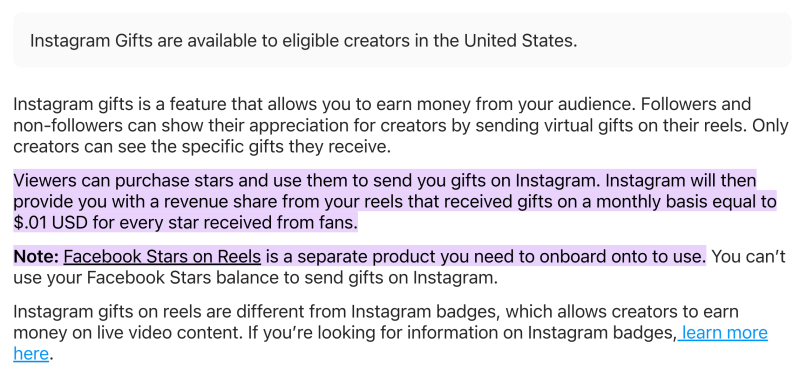
Finally, for most creators, they do not get the algorithmic boost of network effects. These effects are reserved for creators who will bring in ad revenue, likely with 100,000+ followers. Sure, Metcalfe's law says that the value of a network increases as the square of the # of users of the network, but that is a global network effect, not catered to an individual creator.
The algorithm decides who gets to take advantage of Reed's Law, boosting groups in the network that pay to play (paid vs organic content).

There has to be a better way.

RSS & Simultaneous Omni-Channel Distribution
RSS+ upgrade (Social Graph Engagement Aggregator + Blockchain)
Revenue Share & Blockchain Payment Rails (micro and macro transactions)
Micro-Network Effects With True Fans & True Communities
I'll get more into the details below, but here's a quick overview of each solution:
RSS is a technology that enables simultaneous cross-posting to any number of platforms. Cross-posting like this is referred to as "omni-channel marketing" and is one of the best ways for creators to diversify their posting portfolio. E.g., with my podcast, I can upload it to one location, distribute via RSS, and it is sent to all podcast "readers".
The consumer is able to consume where they like, the creator is able to host where they want. Note: this is referred to as "headless marketplaces", and is how I found Farcaster after reading this Variant article.
RSS+, the original name of Farcaster, got the "+" by adding a social graph to Farcaster, authenticated via blockchain.
The addition of blockchain to Farcaster enables payment rails built into the social graph from the ground up. Verified identity & crypto rails enable instantaneous creator payout and revenue share with fans who promote their creations.
The addition of revenue share gives fans some skin in the game. They are rewarded for sharing the works of creators. When they pay it forward, creators pay it back.
This reciprocity between creator and fan helps build what I call a "True Community". The True Community are the players in the game of the world built by the creator 🌍
This True Community forms micro-network effects that leverage Reed's law, boosting the value of the Creator and the True Fans, simultaneously 🤝
Now, let's dive a little deeper ✨

We need to think about the Internet differently if we are to make a true run at decentralized social systems
We need to think in terms of direct linkage between the creator and the consumer in a post-platform manner (independent of the platform the user views the creations on), AKA building for headless marketplaces.
RSS was originally intended to provide this linkage.
RSS stands for Really Simple Syndication and was invented for consumers to directly receive the outputs of creators. (Note, I use the term "creator" for artists, writers, knowledge workers, builders -- people who create and output anything)
Originally, consumers could subscribe to RSS feeds from their favourite blogs and receive the posts in the reader of their choice. The creator and the consumer were directly linked with no intermediary. If a user didn't like the RSS reader anymore, they could move their feed to a different client (reader).
Unfortunately, with the rise of web2 and the associated risks of building on the quicksand of closed-system platforms, RSS lost out to the network effects being generated behind walled gardens.
Web2 social networks used APIs to kill RSS on their platforms, which made it difficult for users to track identities of the people they had followed on, e.g., Twitter.
There was no distributed social graph.
This lack of identity linkages meant that RSS could not keep up with web2 social media platforms as users scaled via network effects in the late 2000's and early 2010's. Users stayed on platform because there was a centralized network effect that boosted their engagement... for the short term.
I get more into RSS and its failure in my long-form newsletter (linked at the end). For now, it's useful to note that RSS technology is still used today for blogs and, perhaps more commonly, podcasts.

RSS failed because there was no way to properly track user identities across the system in a way that maintained the decentralization of RSS itself.
RSS is effectively a system of metadata file usage and information transfer. The information packet goes from one person (the creator) to another (the consumer). Writer 🤝 reader.
There was a direct link between the two.
According to Dan Romero, one of the co-founders of Farcaster, the “+” came from introducing a social graph in a manner that allowed for identity verification across the RSS distribution.
Blockchain enabled the +
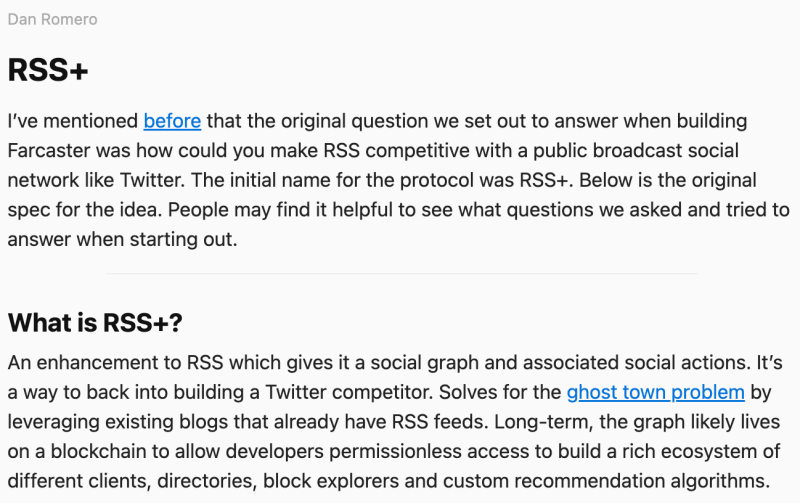
By linking an identity to blockchain on the Farcaster protocol, it’s now possible to have a decentralized social graph that receives all posts (casts) on the network, from any source.
With blockchain, any “reader” can check the authenticity of the "writer" (caster) and approve the cast to be added to the Farcaster network.
The powerful part of this system isn’t only with creators distributing their casts to the entire network (though that helps with burnout, they only have to cast once), the powerful part is that the consumer can also verifiably interact (i.e., engage) with the cast, and engagement is logged in the network.

web3 social graphs enable creators to pay back fans who pay it forward
When using Farcaster (aka RSS+), the social graph is used to verify both the creator and the consumer.
This connection has at least three benefits:
Engagement aggregation;
1-click, in-app purchasing; and
Revenue sharing with fans.
One of the main reasons I started using Paragraph is that when a Paragraph post is shared as a frame on the Farcaster protocol (e.g., on Warpcast), any comments below that frame get automatically pulled into the comment section of my Paragraph Post 🤯
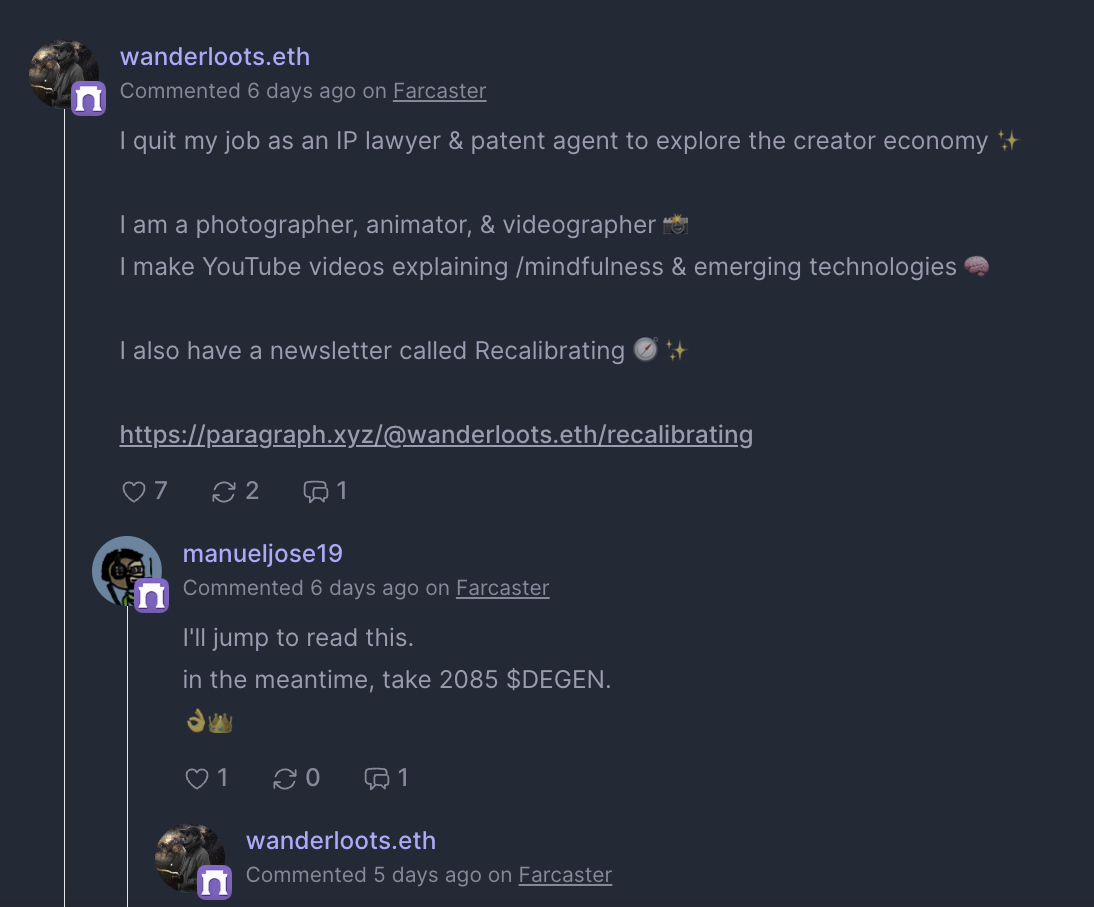
Feedback from fans is aggregated to a single location for me and others to review and respond.
This feature goes a long way for leveraging the social graph of Farcaster to reduce burnout of creators, enabling them to conserve energy by building community via their own posts, rather than fracture their attention across 10+ platforms.
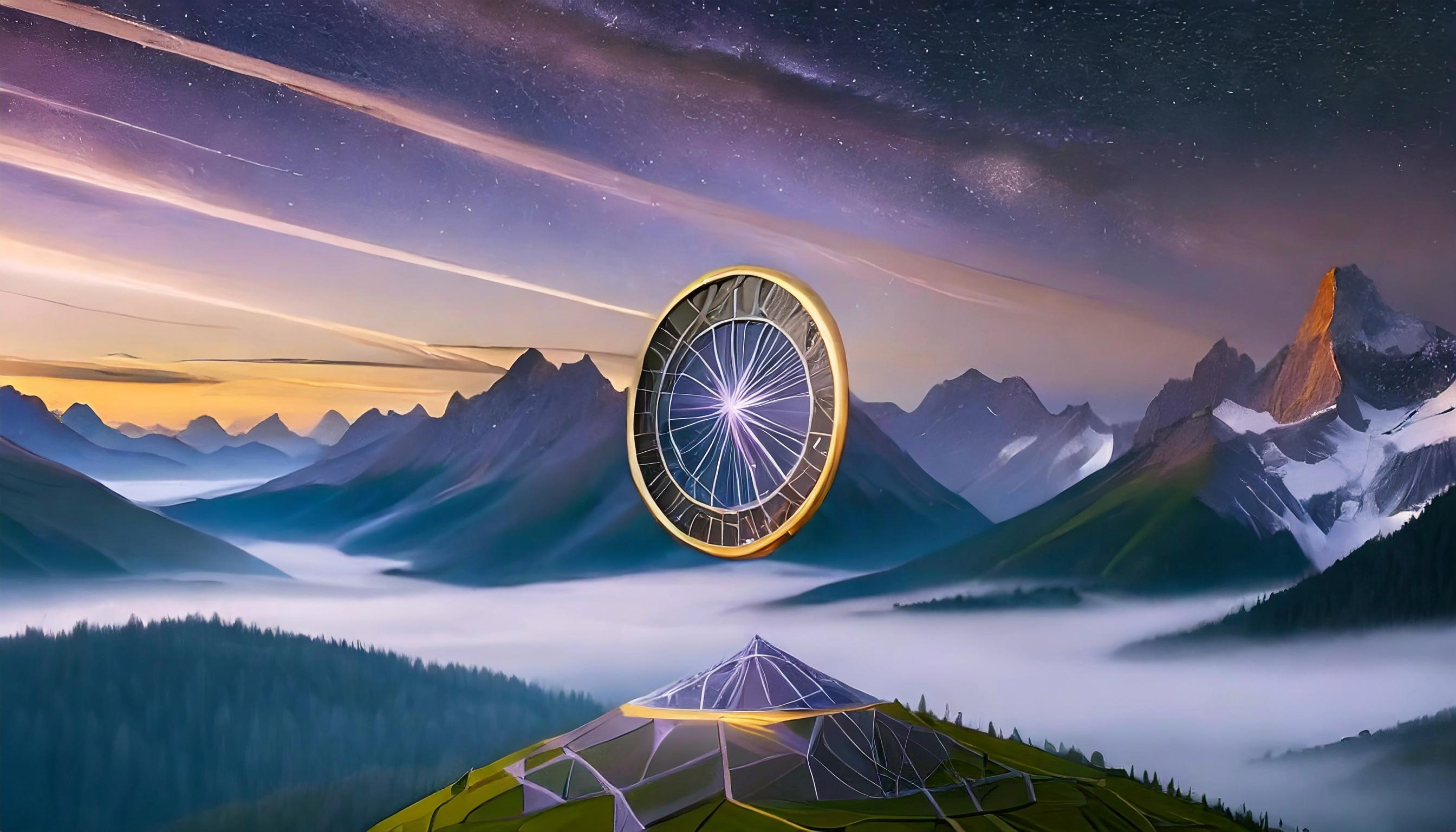
Amazon made many billions from its 1-click checkout patented technology. This same technology is now available within Farcaster via "pay-with-warps", the in-app currency, used in frames.
For more on the value of this system and why I think this is, perhaps, the biggest game-changer to social media since the introduction of video, I have a long-form entry here.
NOTE: frames are getting full transaction support in the near future, which means that in-app payments won't be limited to warps, plan accordingly 👀
Accordingly, creators can create and share a product (e.g., NFT, digital download, print, video) and consumers can instantly purchase that good without leaving the app. Due to the RSS nature of Farcaster, the creator can post this product on any platform linked to the social graph, and the consumer can view the product on any platform linked to the social graph. A headless marketplace.
This direct payment allows for direct micro-transactions in social media. As a consumer, if you come across a value packet that you truly value, you can give $1 (or more) to the creator as a sign of thanks. In return, the creator can give you a token of their appreciation (literally, an NFT).
This builds the creator's 10,000 True Fans. At a few dollars a year, 10,000 True Fans enable sustainable creator monetization.
When added to a subscription system (e.g., Hypersub by Fabric), this consistent low-level monetization can generate sustainable and consistent income (more on this in the next entry).

Now, if the consumer doesn't want to buy the good, but thinks their network would enjoy it, they can reshare the post (recast, quote cast).
Since you are each connected to the same social graph via blockchain authentication, the sharing of the post gets tagged with your unique digital identifier (FID).
If the shared post converts (someone else buys or subscribes), the fan who shared can get a commission for helping to market the creator's work.
When they pay it forward, you can pay it back.
As the creator's community grows, a micro-network forms within the overall Farcaster network, a True Community of fans that help monetize and sustain their creators.
As the network of micro-transactions grows, the creator gets more and more feedback on what works and what doesn't. They're able to recalibrate their system to make it even more valuable.
Eventually, the time will come for the creator to build an even bigger, higher value project. E.g., $500 - $1000 per transaction.
If the creator is able to leverage the micro-network effect they have built with their 10,000 True Fans, ideally, they will be able to find 100 True Fans to buy the high-ticket item. At 100 fans X $500, the creator can make $50,000 in one go. Note, this system can leverage revenue share too, with each transaction earning the referrer $50+.
Effectively, once the micro-network foundation is built, creators can work to have yearly crowdsourced projects that give them financial freedom to continue building their vision, their world, supported by people who have skin in the game, sharing in revenue generated by the continued success of the creator.

By leveraging an RSS style feed, creators can post in a single location (their website) and immediately distribute reformatted content across all social platforms (this is what Worldbuilding is about).
By introducing blockchain, the RSS feed is upgraded to RSS+, adding a social graph and payment rails.
By adding a social graph and payment rails, creators can: be instantaneously paid, aggregate engagement, and reward their fans for helping with conversion (making sales, increasing subscribers, etc).
By rewarding fans for helping them market (via resharing content), a community is built with a shared interest in seeing the creator succeed. A True Community.
This True Community can generate a micro-network effect, helping scale whatever project the creator is looking to build when they are ready to to level up their world.
A synergistic & sustainable creator economy ✨
The full long-form entry can be read on Substack or wanderloots.com. In this entry, I provide more context and depth on the issues described in this post, including my own current experience with the creator economy and predictive examples on how I see this system developing.
I hope this deeper analysis helps you see the bigger picture of what is being built here. A glimpse of the world I am building 🌍
There are four ways you can support my writing on Paragraph:
Subscribe to future entries, my Substack, or my podcast🫡
Share this post with a friend (if you add your wallet address, you can get referral rewards)
Collect this writing token (100 available at 0.001 ETH)
Collect the cover art token (infinite supply & free)
Any and all support is much appreciated ✨





Such a great read!
Ok, but what if I feel weird about getting paid to recast stuff? 🤔 What if knowing that ppl are getting paid to shill stuff makes me want to unfollow them? 🤔 One part of me loves the idea of monetizing your network in guerrilla style marketing. It's really effective, why shouldn't this be normalized?? The other part of me feels like it's going to erode people's social network and amps users will just start to become like web2 influencers and it'll kickstart the demise of the vibes in Warpcast and push ppl to alternative clients that have 'amps filters' or something. Well, maybe it's a win-win in that case... but I still feel weird about the idea of getting paid to shill something and following people who do too. Like, what if the recast included the exact amount that was paid, so everyone viewing it could see exactly how much it cost to purchase their attention space. Would that lesson the impact of the recast? Increase it? Have no effect whatsoever?
what if you could see *who* paid to have this person shill something to you? Would that change the value proposition for a potential use-case of this kind of tool?
What if the amount you get paid is flexible depending on how much the shilled content is similar to what you normally casted? This would proxy familiarity with the topic. It sounds like the direction should be to reward people for word-of-mouth marketing without it becoming artificial shilling
I agree, being "qualified" to access a paid recast could be interesting! My mind immediately always goes to "how will this be gamed?" Would be interesting to see a system that effectively identifies what you're qualified to recast without incentivizing ppl to just spam content to earn qualifications...
this could be a good insight @phil
Yeah I get both sides! Though I think boosting is actually more common than you might think. The key here imo is that it’s for people you follow, so you’ve filtered who you are likely to recast. Additional filter preferences would be good. But also, in an algorithmic system, I miss lots of things I would have recast had I seen it. If it means that much to someone that I/my network see it, I feel like monetizing that “value” is possibly a good thing. I think also that it will depend on how it gets used and the rules applied (eg can announce a launch of something, but not shill something sellable)
Great insights! I agree with your positive cases for it. I also see your point that the devil will be in the details for filtering, etc. It's exciting to see something fresh to experiment with!
Yeah! Exactly, each person will (I’m sure) at some point be able to control exactly the criteria for eligible automated recasts It’s leveraging micro network effects to breach the macro network echo chambers. I actually wrote a bit about this a little while ago: https://paragraph.xyz/@wanderloots.eth/worldbuilding?referrer=wanderloots.eth
I have similar mixed feelings that have kept me from trying @ampsfun thus far, so thanks for writing this. I like the idea of getting paid to recast something I would have recasted anyway, especially on Farcaster. I want the Farconomy to succeed. But I also think it's wise to tread verrrry carefully with things like this because I've seen economic incentives erode community goodwill and trust in so many different ways. Still not planning to try it myself, but I'm definitely watching the experiment with keen interest and taking notes.
Well said! I definitely like the idea of paying ppl to recast stuff they'd recast anyway. But doing it up front seems counter intuitive to the "would do it anyway" part... Retroactively doing it just creates airdrop farming spam... Interesting problem/opportunity space! Glad smart minds are poking at it!
this is a really great graphic by @zain describing @phil 's @ampsfun Micro-network effect --> macro-network effect = a win for creators While it may not seem like it with the algorithmic feeds of socials today, a lot of what boosts creators is the mindshare of other creators/readers with followings that boost content via reshares (quote tweets, share to storey on insta, referencing content in YT videos). Also, a lot of people think this happens for free, when in fact, many creators get paid to reshare the work of other creators. Brands do this all of the time, but so do creators. Amps helps automate this process by allowing creators to establish a share price and the recaster to automatically receive payment for the reshare. I actually wrote about this effect last year, analyzing the impact of micro-network effects: https://paragraph.xyz/@wanderloots.eth/worldbuilding
tbh, I think frames are still drastically underrated as a technological social primitive. Being able to create any user experience and generate a "window" through a social feed with direct engagability from the user solves so many issues we see with trad socials Frames are what first brought me to fc, and I share more thoughts here: https://paragraph.xyz/@wanderloots.eth/worldbuilding/?referrer=wanderloots.eth
The /positivesum manifesto Positive Sum is a Farcaster community dedicated to empowering newly arriving creators to find their footing and seasoned users to share their insights. We believe that as Farcaster thrives, everyone benefits. Our immediate mission is to help new users thrive in their first 30 days on @farcaster and we need a community to help us achieve this. @eriks and I are soft-launching with our friends as we develop our community playbook for the first 30 days. If this sparks your interest go here /positivesum and join us. Second, please read the manifesto and share your thoughts. cc: @eriks https://paragraph.xyz/@jonathancolton.eth/positive-sum-manifesto
we rise together jonathan!
yes we do!
it is the only way!
This sounds amazing! @eriks @jonathancolton 👏 I have many, many ideas lol, which is shocking I’m sure. I have some resources already on explaining fc to people, I’ll see if I can consolidate some
Thank you Cal! We would love to hear your ideas and appreciate any resources you can share. 💜 💜 CC: @eriks
will hopefully be able to join the next tavern! here's an article in the meantime, goes more into the philosophy of what it means that Farcaster was originally named RSS+ and distinguishing from web2 social media: https://paragraph.xyz/@wanderloots.eth/worldbuilding?referrer=0x316822580ee3725209fD96b1208ef53b73825E56
🤍 🤍 🤍 100 $degen
thank you Beatriz! 💜 🫂
🫂
🫡
🫡
I want to invite newer users who I know and have met @sarasebteyni, my good friends @iraconda, @dirtnoise (who just came back) and @studi08f0rev3r all trying to navigate come here for some resources. 💜
This is awesome @jacque! Welcome to /positivesum @sarasebteyni @iraconda, @dirtnoise and @studi08f0rev3r We invite new or new-ish creatives to join /positivesum with the link. They should introduce themselves and their work to the community with an introductory cast, like this one https://warpcast.com/jeroenv78/0x6240e06a. We have a community that wants to support them with: - follows, likes, recasts, and tipping. - Introduce them to channels. - Mentor them if possible or required - provide them with resources like a 30-day success plan -Have weekly community Happy Hours We are in the testing phase and are refining this process as we go along. https://warpcast.com/~/channel/positivesum/join?inviteCode=pIy2hZHfLgjTZhBr_-b7Og cc: @eriks
Beautiful.... what you are doing for the community! ❤️
welcome to fc and to /positivesum! 🌱
👻🖤
Awesome initiative fam! 💙🔥
thanks man! I hope you will join us.
I love it
I hope you will join us on this journey!
I will try to do my best
Ok, about time I read this
What were your thoughts? My first question is whether our mission is too narrow. That's one of the things that I want to discuss on the community call tomorrow.
Maybe, how do you discover new users? Or it could be an active movement towards onboarding people we know and want to bring here
Very cool man! going to be a fantastic channel
Love this initiative 🤍
Last week, I imported my substack subscribers to @paragraph, but now I'm wondering how it works to import the posts as well? @colin, you mentioned that there are some UI changes coming: 1) If I import all of my substack articles from the last 2 years, do they get slotted chronologically into my paragraph feed? 2) Will I have control over the layout in the future?
Yes to both. Let us know any feedback on migrating any posts! Also love hearing feedback on using Paragraph, so don't hesitate to reach out as you get ramped up.
awesome! thanks so much 😊 my thought is that I want to import my previous writing, but I have some more paragraph/farcaster specific articles on paragraph, so I don't want them to get lost in the 60+ other posts I bring in will give it a go and let you know! re: feedback, I've been writing on paragraph since february and really love the options for token-gating, minting, and distribution. One piece of feedback would be to provide better statistics/metrics for the articles. right now, I can only see open rate/views and monetization. On substack, I had wayyy more data on who was clicking on what, how they found the articles, where they opened them, etc.
Totally get it, we definitely want to improve analytics on Paragraph over time — appreciate the note. Keep any other feedback coming. It's hugely helpful. 🙏
In this article, I describe the value of Farcaster as it relates to traditional social media. I touch on decentralization, channels, distribution methods, and network effects, along with the power of frames ✨ I hope it helps anyone looking to learn more about the technical benefits of building in DeSo 🫡 https://paragraph.xyz/@wanderloots.eth/worldbuilding?referrer=0x316822580ee3725209fD96b1208ef53b73825E56
A warm welcome to the Brazilian artists that just joined Warpcast✨ Please support them following and engaging with their content: @rosamorena @paulissonmiura @budastudio @fitipe @photoevaporation @raffagomes @alexandre-rangel @lunatico If you know of other artists from Brazil who have joined us recently, please tag them in the replies.
In this thread you can find other Brazilian artists to support: https://warpcast.com/narisofka/0x63c79eae
cc: @polymutex.eth @downshift.eth @maretus @samuellhuber.eth @priyanka @fercaggiano @angelikakollin
absolute class. ty 🫡
Marcelo always shows up for art & artists.
How to best help here? What do you as artists love the most? In terms of follows and conversations I’d suggest dming @wanderloots.eth @priyanka @pichi as they‘ll be able to guide 1:1 from an Artist Point of view
Gm Samuel, we are working on different fronts: mapping Brazilian artists who want to join Warpcast, generating gift invitations, onboarding, producing material in Portuguese about the Warpcast etc. But the biggest challenge is: many people from different places (artists, collectors, curators, galleries and platforms) have stopped using Warpcast in recent months. It's really important that they come back. In this way, we'll have access to their content and we'll be able to keep in touch with them. If they only use Twitter, we from Brazil will lose the contact with them and their content.
Absolutely! Happy to help answer any questions 😊 I also have intro guides on my Paragraph (linked in /cal) that helps explain the whole ecosystem. From a channel perspective: /itookaphoto /cryptoart /superrare /photographers /photography /lightchasers /art Are all great places to vibe with other artists. I recommend engaging with replies at least as often as you cast yourself, as that’s the best way to find a community you resonate with ✨
Seguindo a galera aqui tb.
🔥🔥🔥
Thank you to everyone who helped to spread this cast! Maybe you will like the thread: https://warpcast.com/marcelonada/0x696aa2a8
Thanks for sharing!
Ótima lista Marcelo! Vou seguir geral
Maravilha Gill!
bom dia
Bem vindos! Segui geral, espero que curtam o role ✨✨
Done!
also @leylabuk please :)
and @artcarolinabf ➕
Unsolicited Farcaster improvement suggestion: When you go to open an account and before you pay your $5 there should be a welcome screen explaining to you the benefits of having a Warpcast account. In particular it should mention the immutability and genuine ownership aspects of having an account on a decentralized platform. It should also explain that it’s an open platform that people can code different features onto so you should expect that. It will reduce the learning curve for new users and also spread the word about the positives of having an account here rather than elsewhere. I’d also like to know these things as well but I just figured them out on my own and with the help of people on the platform generously giving their time. A one page intro to Farcaster breakdown for newbies would be great I suspect.
I'm supporting you through /microsub! 112 $DEGEN (Please mute the keyword "ms!t" if you prefer not to see these casts.)
Yeah that’s a good call, though I think most of the words would go over people’s heads. Usually takes me much more than a page’s worth of words to help people get it haha Could frame it as RSS+ as that was the initial idea, but again, most people don’t understand rss 🤷♂️ You might also find this interesting: https://paragraph.xyz/@wanderloots.eth/worldbuilding/?referrer=wanderloots.eth
I'm supporting you through /microsub! 111 $DEGEN (Please mute the keyword "ms!t" if you prefer not to see these casts.)
I'm supporting you through /microsub! 110 $DEGEN (Please mute the keyword "ms!t" if you prefer not to see these casts.)
I'm supporting you through /microsub! 108 $DEGEN (Please mute the keyword "ms!t" if you prefer not to see these casts.)
I'm supporting you through /microsub! 122 $DEGEN (Please mute the keyword "ms!t" if you prefer not to see these casts.)
I'm supporting you through /microsub! 120 $DEGEN (Please mute the keyword "ms!t" if you prefer not to see these casts.)
I'm supporting you through /microsub! 73 $DEGEN (Please mute the keyword "ms!t" if you prefer not to see these casts.)
I'm supporting you through /microsub! 73 $DEGEN (Please mute the keyword "ms!t" if you prefer not to see these casts.)
when you are paying $5 to sign up, they should show a cast from a user that got paid $5 for being a top caster then you know exactly what you're paying for
Is there a way to return to the gif cover art for @paragraph? Would love to be able to remove the lower portion of the cover art and just use the art I designed originally: https://paragraph.xyz/@wanderloots.eth/worldbuilding?referrer=wanderloots.eth
@colin just wondering if you have any thoughts?
There's no easy way, we migrated to the new "social sharing" banner that you see and it's not clear how we can support animated gifs in that
hmm okay, thanks for letting me know tbh, I significantly prefer the previous banner. This one looks a bit tacky and removes the design component of marketing articles (something I know lots of people put a lot of effort into)
Will be building off of the concepts from this article during tomorrow's @farhouse space 🎙️ imo, micro-network effects are boosted in web3 due to the direct creator-fan relationship 3 pm EST tomorrow ✨ invite code 👇 https://paragraph.xyz/@wanderloots.eth/worldbuilding?referrer=wanderloots.com